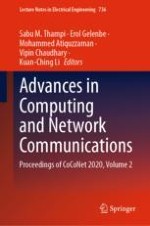2021 | OriginalPaper | Chapter
Early Detection of COVID-19 from CT Scans Using Deep Learning Techniques
Authors : P. Limna Das, A. Sai Manoj, Sachin Sharma, P. B. Jayaraj
Published in: Advances in Computing and Network Communications
Publisher: Springer Singapore
Activate our intelligent search to find suitable subject content or patents.
Select sections of text to find matching patents with Artificial Intelligence. powered by
Select sections of text to find additional relevant content using AI-assisted search. powered by
